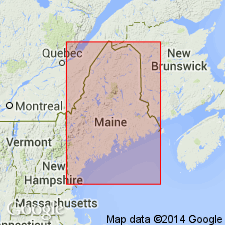
- Usage in publication:
-
- Digdeguash Formation
- Modifications:
-
- Named
- Dominant lithology:
-
- Graywacke
- Slate
Summary:
Rocks in the Pleasant Ridge and St. David Dome areas in Charlotte Co., New Brunswick, previously named the Canoose Formation by MacKenzie (1940), are here named the Digdequash Formation. [The name Digdeguash is used in all subsequent references to the unit.] It is composed of dark-gray and olive-green quartz wacke, silty slate, and slate. Grades laterally into the facies equivalent Waweig Formation. Age is Late Silurian and Early Devonian.
Source: GNU records (USGS DDS-6; Reston GNULEX).

- Usage in publication:
-
- Digdeguash Formation
- Modifications:
-
- Areal extent
- Age modified
- AAPG geologic province:
-
- New England province
Summary:
The Digdeguash Formation extends from Pleasant Ridge, New Brunswick, CAN, to Third Chain Lake, ME. Interfingers with the Silurian Waweig Formation, with which it is partly equivalent; grades upward into the Flume Ridge Formation. Age is Silurian.
Source: GNU records (USGS DDS-6; Reston GNULEX).
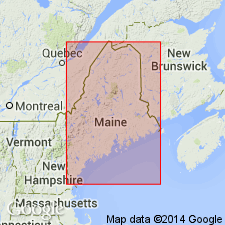
- Usage in publication:
-
- Digdeguash Formation
- Modifications:
-
- Revised
- Age modified
- AAPG geologic province:
-
- New England province
Summary:
Digdeguash Formation is here assigned to the Cookson Group. According to recent mapping Digdeguash and Kendall Mountain Formations appear to be continuous near Moore Mills Lake. Similar laminated siltstone and shale beds in the two units suggest that both belong to the Ordovician Cookson. Digdeguash previously considered to be Silurian and separated from the Cookson by the Honeydale fault. Newly exposed beds of calc-silicate in the Digdeguash northwest of Moores Mills Lake are similar to those in the Woodland Formation. The upper part of the Digdeguash is correlated with the Pocomoonshine Lake Formation. The stratigraphic order of units within the Cookson is revised following the discovery of Caradocian graptolites in the Kendall Mountain Formation. Cookson now divided into ascending Calais, Woodland, and Kendall Mountain Formations. Digdeguash and Pocomoonshine Lake Formations are interpreted as lateral equivalents of the Woodland. Age of Cookson therefore changed from Late Cambrian and Early Ordovician to Early, Middle, and Late Ordovician. Contact between Digdeguash and overlying Silurian Flume Ridge Formation now interpreted as a major fault.
Source: GNU records (USGS DDS-6; Reston GNULEX).
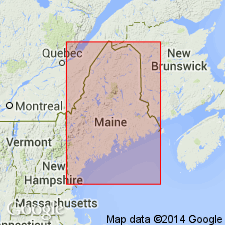
- Usage in publication:
-
- Digdeguash Formation
- Modifications:
-
- Revised
- Age modified
- AAPG geologic province:
-
- New England province
Summary:
Author disagrees, in part, with revisions of Cookson proposed by Fyffe and Riva (1990). Though he agrees that fossil evidence requires inversion of the stratigraphic sequence, he states that the Pocomoonshine Lake and Digdeguash formations are more likely a part of the Fredericton belt rather than of the St. Croix terrane and therefore are not part of the Cookson Group. Interpretation is based on lithologic and structural evidence. As here revised the Late Cambrian(?) to Middle Ordovician Cookson comprises (ascending) Calais, Woodland, and Kendall Mountain Formations. Author states there is no evidence for the correlation of the Digdeguash and Woodland Formations proposed by Fyffe and Riva (1990). Cookson Group tectonically underlies Pocomoonshine Lake Formation, which conformably underlies Digdeguash. Digdeguash is here assigned a Silurian age. Underlies Silurian and Devonian Flume Ridge Formation.
Source: GNU records (USGS DDS-6; Reston GNULEX).
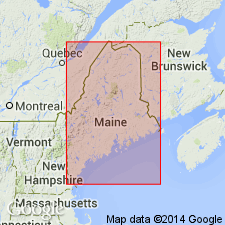
- Usage in publication:
-
- Digdeguash Formation
- Modifications:
-
- Age modified
- AAPG geologic province:
-
- New England province
Summary:
Supposed plant fossils reported by Bailey and Matthews (1872), MacKenzie (1940), and Ruitenberg (1967) in the Flume Ridge Formation are now interpreted as inorganic. Therefore "* * * assignment of specific ages to the Digdeguash and Flume Ridge is unwarranted. It can only be surmised that this thick package of rocks is older than the unconformably overlying Carboniferous strata and is likely younger than the Ordovician Cookson Group, which apparently stratigraphically underlies it." A Late Ordovician to Silurian age is suggested for the Flume Ridge. The Ordovician-Silurian boundary occurs either near the base of the Flume Ridge or within the Digdeguash.
Source: GNU records (USGS DDS-6; Reston GNULEX).
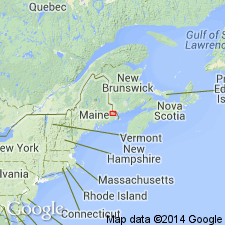
- Usage in publication:
-
- Digdeguash Formation
- Modifications:
-
- Age modified
- AAPG geologic province:
-
- New England province
Summary:
Pocomoonshine Gabbro-Diorite intrudes the Pocomoonshine Lake, Digdeguash, and Flume Ridge Formations in the Fredericton belt and cuts the Kendall Mountain and Woodland Formations of the Cookson Group in the St. Croix belt. The pluton was emplaced during two separate episodes during the Silurian Period. 40Ar/39Ar hornblende ages form the northern mafic portion indicate crystallization at 422.7+/-3.0 Ma. Muscovite plateau age of 414.2+/-3.2 Ma is minimum age for central and southern dioritic portions of the pluton. Therefore, deposition of the Pocomoonshine Lake, Digdeguash, and Flume Ridge Formations is constrained to Late Caradocian (early Late Ordovician) through Early Silurian. The Cookson Group is interpreted as Late Cambrian(?) through Late Ordovician. According to authors, a major episode of folding and regional metamorphism must have taken place during the Silurian. Melding of the Fredericton, St. Croix, and Coastal Volcanic belts into a single block must have occurred by the Silurian. Accretion of this composite block to ancestral North America, then, was probably responsible for the Acadian Orogeny in northern New England.
Source: GNU records (USGS DDS-6; Reston GNULEX).
For more information, please contact Nancy Stamm, Geologic Names Committee Secretary.
Asterisk (*) indicates published by U.S. Geological Survey authors.
"No current usage" (†) implies that a name has been abandoned or has fallen into disuse. Former usage and, if known, replacement name given in parentheses ( ).
Slash (/) indicates name conflicts with nomenclatural guidelines (CSN, 1933; ACSN, 1961, 1970; NACSN, 1983, 2005, 2021). May be explained within brackets ([ ]).

